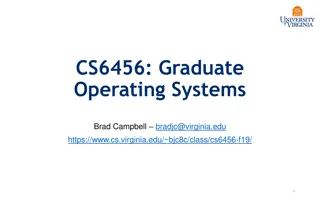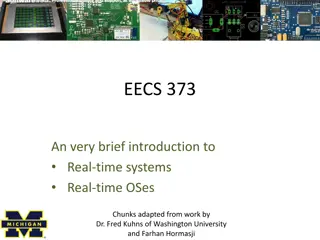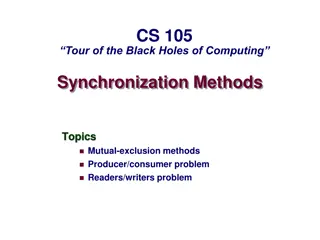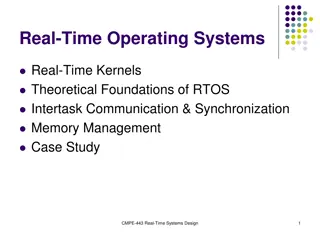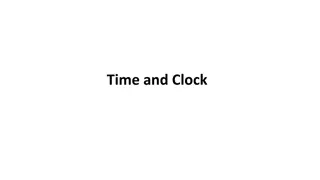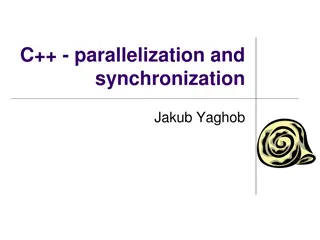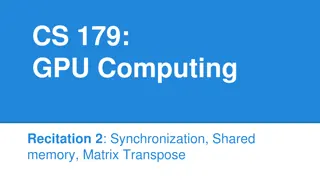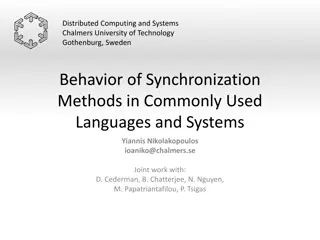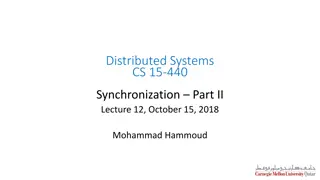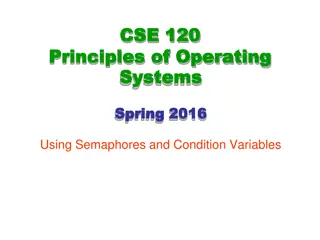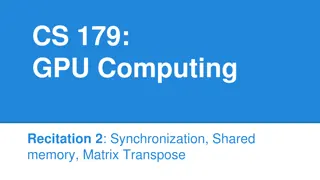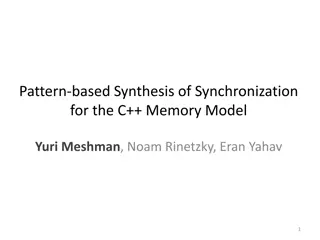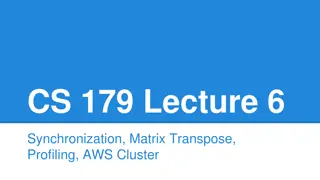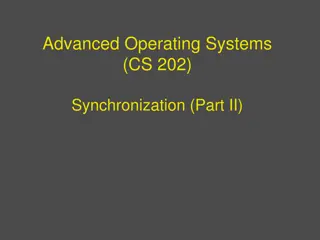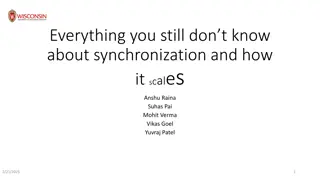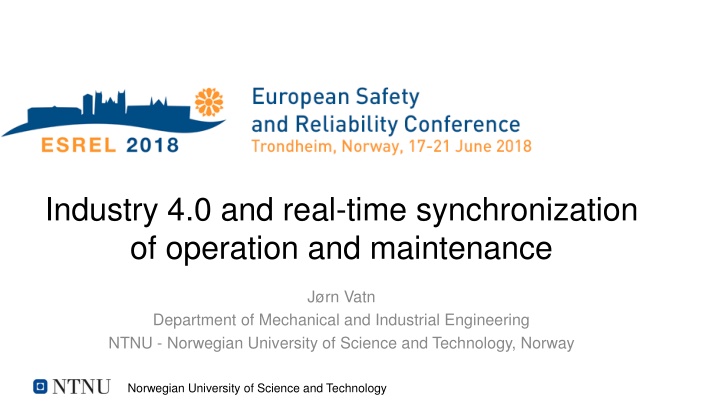
Industry 4.0 and real-time synchronization
Explore the integration of Industry 4.0 concepts for real-time operation and maintenance synchronization. Learn about digital twins, IoT, cloud computing, and more at the Norwegian University of Science and Technology.
Download Presentation

Please find below an Image/Link to download the presentation.
The content on the website is provided AS IS for your information and personal use only. It may not be sold, licensed, or shared on other websites without obtaining consent from the author. If you encounter any issues during the download, it is possible that the publisher has removed the file from their server.
You are allowed to download the files provided on this website for personal or commercial use, subject to the condition that they are used lawfully. All files are the property of their respective owners.
The content on the website is provided AS IS for your information and personal use only. It may not be sold, licensed, or shared on other websites without obtaining consent from the author.
E N D
Presentation Transcript
Industry 4.0 and real-time synchronization of operation and maintenance J rn Vatn Department of Mechanical and Industrial Engineering NTNU - Norwegian University of Science and Technology, Norway Norwegian University of Science and Technology
Background Maintenance decisions needs to take into account Current state of the component, system etc ( real-time ) Cost of maintenance and failures taking current operational context into account ( real time ) Future loads affecting the probability of failure These loads may be influenced by changing operational profiles Can we use Industry 4.0 concepts to approach the challenges? Norwegian University of Science and Technology 2
Objectives Elaborate on basic elements of Industry 4.0 Digital twin, stochastic digital twin Real-time Digital twins interacting Present elements of a case study: towards a set of interacting digital twins Norwegian University of Science and Technology 3
Industry 4.0 (Forth industrial revolution) Industry 4.0 is a collective term particularly used in manufacturing to emphasize technologies and concepts of value chain organizations Related terms Cyber-Physical Systems the Internet of Things Cloud computing Digital Twin Although the term originates from the manufacturing industry, the elements of Industry 4.0 are relevant for most businesses (Maintenance 4.0, Safety 4.0, Ship 4.0, ) The current usage of the term Industry 4.0 has been criticized as essentially meaningless Focus on the elements rather than the term Industry 4.0 as such ! Norwegian University of Science and Technology 4
IoT -Internet of Things The Internet of Things (IoT) is the network of items embedded with electronics, software, sensors, actuators, and network connectivity which enable these objects to connect and exchange data IoT is what we need to connect Norwegian University of Science and Technology 5
Cloud computing Cloud computing is an information technology paradigm that enables access to shared pools of configurable system resources In some presentations the term Internet of Services (IoS) rather than cloud computing With cloud computing we do not need to think about platforms, how to connect etc Norwegian University of Science and Technology 6
Digital twin The digital twin refers to a digital replica of physical assets, processes and systems that can be used in real-time for control and decision purposes Computerized mathematical model (what we have done over years) Real-time, thanks to IoT In contrast to a physical asset, the digital twin can immediately respond to what-if inquiries Norwegian University of Science and Technology 7
Garnter TOP 10 (2019): The notion of a digital representation of real-world entities or systems is not new. Its heritage goes back to computer-aided design representations of physical assets or profiles of individual customers The difference in the latest iteration of digital twins is: The robustness of the models with a focus on how they support specific business outcomes such that high reliability and efficient maintenance Digital twins link to the real world, potentially in real-time for monitoring, and control The application of advanced big data analytics and AI/ML to drive new business opportunities The ability to interact with them and evaluate what-if scenarios Norwegian University of Science and Technology 8
Draft DNVGL-RP-A204 Qualification and assurance of digital twins The capability of DTs can be ranked on a scale from 0 5: 0-standalone 1-descriptive 2-diagnostic 3-predictive 4-prescriptive 5-autonomy Norwegian University of Science and Technology 9
Off-line digital models Remaining useful lifetime (RUL) models have been available First principle approaches (white box) Probabilistic models (gray-box) Data driven models / ML / AI (black box) These models exists, but are mainly used as off-line models Norwegian University of Science and Technology 10
The need for on-line models For predictive maintenance 1. Anomaly detection 2. Diagnostic 3. Prognostics / RUL Norwegian University of Science and Technology 11
The need for on-line models For predictive maintenance 1. Anomaly detection 1. Machine learning 2. First principles 3. Signal processing (FFT) 2. Diagnostic 1. Signal processing (FFT) 2. Machine learning 3. Prognostics / RUL 1. Not much Norwegian University of Science and Technology 12
The need for decision support For anomaly detection False positives and false negatives Sensor drifts Long term drifts in the process, which is not related to physical degradation Diagnostic Is treatment required? Prognostics What and when to do hard maintenance Scheduling, taking opportunity windows into account How, will changes in operational loads affect RUL, and what to do? Norwegian University of Science and Technology 13
Prognostics models: RUL Deterioration level, Y(t) Mean RUL L Current time and current state Time, t Norwegian University of Science and Technology
Decisions: m = Maintenance level Deterioration level, Y(t) L m TL = Lead time Time, t Norwegian University of Science and Technology
Decisions requiring DT-inquiries What is the current production demand? Will there be a maintenance opportunity in the near future? Can I relax on production to reduce degradation rate Is it a weather window? How to group maintenance activities, remote operation? Deterioration level, Y(t) L m TL = Lead time Time, t Norwegian University of Science and Technology
Digital Twin vs Stochastic Digital Twin Norwegian University of Science and Technology
Stochastic digital twin A stochastic digital twin is a computerized model of the stochastic behavior of a system where the model is updated in real-time based on sensor information and other information accessed via the internet and the use of cloud computing resources What-if inquiries result in pdf s rather than single values Norwegian University of Science and Technology 18
Real time model vs test model Google maps Traffic vs Google maps Bicycle-friendly routes Norwegian University of Science and Technology
Real-time model A real-time model is a model where it is possible to obtain values of system performance and system states in real-time With real-time we mean that data referring to a system is analysed and updated at the rate at which it is received Norwegian University of Science and Technology 20
Test model A test model is a mathematical model describing relations between future and current values of the variables of interest, but where we are not able to monitor system performance and system sates in real-time Such a model is often referred to as an off-line model or a sandbox model A test model is still valid in order to establish decision rules to be used in real-time Claim: 99.9% of all models presented at ESREL since 1991 are test models because they have no ambitions to connect in real time Norwegian University of Science and Technology 21
Anomaly detection Highlights from: A2.1 MonitorX framework Review of analytics methods supporting Anomaly detection and Condition Based Maintenance First principles Machine learning Objective: Separate anomalies and noise Norwegian University of Science and Technology 22
Motivation Do we spot anomalies? Norwegian University of Science and Technology
First principles The physical equations describing the top oil and hot-spot temperature dynamics are the following The physical model parameters may be estimated from data during normal operation From the model we can predict (estimate) temperature and compare with actual temperature: Norwegian University of Science and Technology 24
Machine learning The first principle model requires a physical understanding of the relation between input (current and ambivalent temperature) and output (hot-spot temperature) If the relation is complex, we can use huge training data sets to estimate the relation between input and output: Norwegian University of Science and Technology 26
Big data analytics and data driven models There are several techniques for these data driven models Classical multivariate regression analysis Artificial neural networks Deep learning Decision tree learning Support vector machines The hot-spot temperature example: Norwegian University of Science and Technology 27
Case study Turnout monitoring Turnouts (switches) are important components in the railway infrastructure, and failure of a turnout will usually give large problems with the circulation, and delays are expected A range of condition monitoring techniques exist BaneNOR is running at test project in Norway where the electric current of the motor is monitored, and represents a signature that can alert a coming failure Norwegian University of Science and Technology 30
Signature (Normal operation) Current 0 0 1 2 3 4 5 Time, seconds Norwegian University of Science and Technology
Indication of a potential failure 2> Threshold? ?? ?? 0 1 2 3 4 5 Actual, a Signature, s Norwegian University of Science and Technology
Digital twins A maintenance twin A production twin (including punctuality) Norwegian University of Science and Technology 33
Digital twin for maintenance (degradation) The focus is on when to act upon a potential failure rather than the classical inspection interval approach A PF-model is used, z(t) = f(t)/R(t) for TPF: ? ? ?,? ? = ?0? ????+???? Where z0(t) = baseline failure rate function, TPF y = degradation level at the point of warning x(t) = future load in the near future (t is typically minutes and hours) ??and ??regression coefficient in the Cox-proportional hazard model Failure F Failure progression Critical failure progression P Time PF- interval Norwegian University of Science and Technology 34
Real-time ? Not actually, the case study is only illustrative But y = current degradation level in real-time is in principle accessible x(t) = future loads This is something the digital twin for the production in principle can respond on, i.e., how many trains are scheduled to pass the coming hours and how many shifting operations are required? In a what-if analysis, we may also investigate what is happening if we relax on operation, i.e., if we move crossing to another station to avoid operating the switch (and reduce the likelihood of a failure) Norwegian University of Science and Technology 35
For example y is obtained in real-time by 2 ? = ?? ?? 0 1 2 3 4 5 Actual, a Signature, s Norwegian University of Science and Technology
Real-time ? Not actually, the case study is only illustrative But y = current degradation level in real-time is in principle accessible x(t) = future loads This is something the digital twin for the production in principle can respond on, i.e., how many trains are scheduled to pass the coming hours and how many shifting operations are required? In a what-if analysis, we may also investigate what is happening if we relax on operation, i.e., if we move crossing to another station to avoid operating the switch (and reduce the likelihood of a failure) Norwegian University of Science and Technology 37
Stochastic digital twin? Yes: ??(?|?,? ? ?? = 1 ? 0 ? ? ?,? ? The cumulative distribution function, F(), is essentially what we need for the optimization: Norwegian University of Science and Technology 38
The objective function to minimize: ? ?,? = ?PM? + ?U? ? ?,? + ?R(?) t = time for when to act upon the potential failure = decision variable x = how many times we operate the degraded switch ?PM? = Cost of preventive action, decreases as function of t, to be obtained from the production digital twin ?U= Punctuality (unavailability) cost upon a failure (production digital twin, or punctuality model) ?R(?) = Relaxing cost, i.e., a function of how many times the switch is operated (production digital twin) Norwegian University of Science and Technology 39
Results It is assumed that maintenance opportunities exist at time 3, 5, 7 and 9 hours at various costs Calculation examples are shown in the paper Result (optimal intervention time, t): Norwegian University of Science and Technology 40
Conclusions Straight forward mathematical models are presented We have demonstrated the need to synchronize maintenance and operation We have indicated what is required, i.e., a maintenance model and a production model that are updated in real- time (the digital twins) We have demonstrated how these twins interact There is still a long way to go get the models actually running in real-time Norwegian University of Science and Technology 41
Thank you Questions? Norwegian University of Science and Technology


